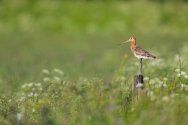Background
Six dilemmas – part 4: How many climate and nature goals does the Netherlands wish to achieve?
The Netherlands has committed itself legally to achieving several climate and nature goals within the next ten to fifteen years. These goals include the Bird and Habitat Directive, the Climate Agreement and the Netherlands Nature Network. Moreover, the Green Deal commitment to becoming fully climate neutral in 2050 will probably be added to these goals, as well as the Nature Recovery Law that stipulates that all ecosystems in the Netherlands must be recovered by 2050. Trade-offs between EU member-states on these goals are not possible.
If trade-offs are permitted, it will be possible to determine at the level of the European Union where these goals may be achieved in a cost-effective manner. Such a system would allow the Netherlands to produce more food in its fertile delta in exchange for other countries achieving a higher level of nature recovery than required. The Netherlands would then compensate these countries for the costs incurred and the missed income. This system of exchanges and compensation is not applicable to all nature goals, such as migratory birds and fish in the Netherlands. However, not all species and habitats are exclusive to the Netherlands.
An exploration of nature-inclusive scenarios for the future shows that a nature-inclusive design of the Netherlands will not achieve all of the nature targets but will significantly improve nature and ecosystem services. To achieve the goals in spite of this fact, the Netherlands may cost-effectively contribute to the protection of species and habitats native to other countries on-site. This will allow us to utilise specific biophysical and geographical characteristics of a particular region. Sparsely populated and forest-rich Sweden, for example, is a much more attractive option for carbon storage than the densely populated Netherlands.
Countries trading climate goals is not a new phenomenon, but it may cause issues to be passed on. For example, planting extensive forests may lead to climate benefits, but at the same time, it adversely affects biodiversity. Moreover, if the Netherlands achieves its nature and climate goals, this will increase the quality of the living environment as well as offer health benefits. Hence, exchanging goals may have undesired consequences.
However, if we do not exchange goals with our neighbouring countries, the Netherlands must be fundamentally (re)designed, which would lead to steep costs. The Netherlands’ food production and exports to neighbouring countries would be significantly reduced, which means these countries would have to cultivate less fertile soils to meet the demand for food. Trading climate and nature rights could help prevent this.
An EU Emission Trading System that allows businesses and organisations in member states to trade emission rights is already in place. This ETS is, however, considered too complex and too severely regulated. A similar system may be developed for the trading of nature goals.
6 dilemmas
The societal debate on agriculture and nature frequently focuses on slashing the livestock population in half and whether we should aim to achieve the nitrogen targets in 2030 or in 2035. But are there the right questions? A group of Wageningen researchers identified six dilemmas contributing to the Netherlands’ future course of agriculture and nature.
In the series “6 Dilemmas”, each of the dilemmas is discussed in more detail.


